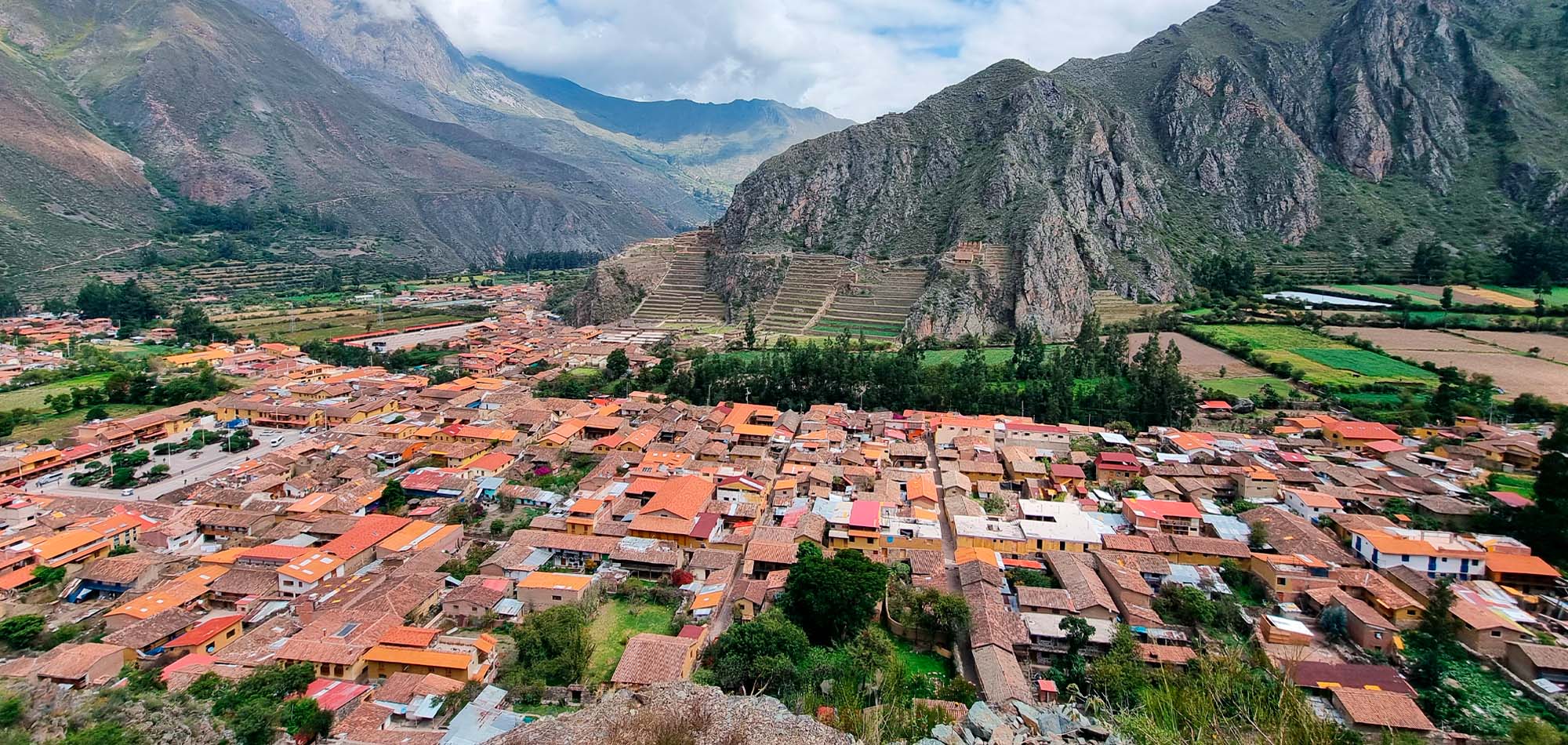
Welcome to Ollantaytambo, Peru, a quaint town with its enormous archaeological site, but forever overlooked because of the more prominent Machu Picchu. Its ancient ruins come from a prolific civilization that rises over a lush and fertile valley. This quiet town has plenty to offer, including pre-Colombian Ancient ruins a most importantly is the gateway to the majestic Machu Picchu citadel. The descendants of the great Inca empire who speak Quechua still live here and call this cute traditional town home.
Ollantaytambo is highly recommended for travelers looking for history, cultural immersion and a place to experience traditions passed down from thousands of years ago that are still a part of daily life.
The Sacred Valley of the Incas is the Urubamba Valley, a 12-mile area in Peru that was inhabited by the Incas until the Spanish conquest in the 16th century. It is rich in Andean culture, which still exists today so visitors can get a feeling for the deep history of the region.
The Incas settled their towns in the Sacred Valley because it was a lower elevation, which resulted in warmer temperatures. More crops were able to be grown in the valley and on the terraces, including maize, which was used to make chicha, a fermented drink that they consumed during ceremonies and celebrations which is still popular today.
On the western side of the Sacred Valley lies Ollantaytambo, a town that is as difficult to pronounce as it is beautiful. It is at the edge of the Andes mountains which eventually descend to the dense vegetation of the Amazon jungle beyond.
The town is thought to have been conquered in the 15th century by the Incan emperor Pachacuti, who rebuilt the town once he conquered it and installed elaborate terracing, an irrigation system, and a fortress. The nobility lived in the town and the terraces were used as farmland. The ruins of this once-great town can still be seen towering over the central plaza today.
Legend has it that Pachacuti’s general, Ollantay, fell in love with his daughter, who was off limits because she was of noble blood. Ollantay revolted and after a long-fought battle and the eventual death of Pachacuti, his bravery resulted in the naming of the town after him.
It is also thought that Ollantaytambo was the last stronghold of the Incas during the Spanish colonization.
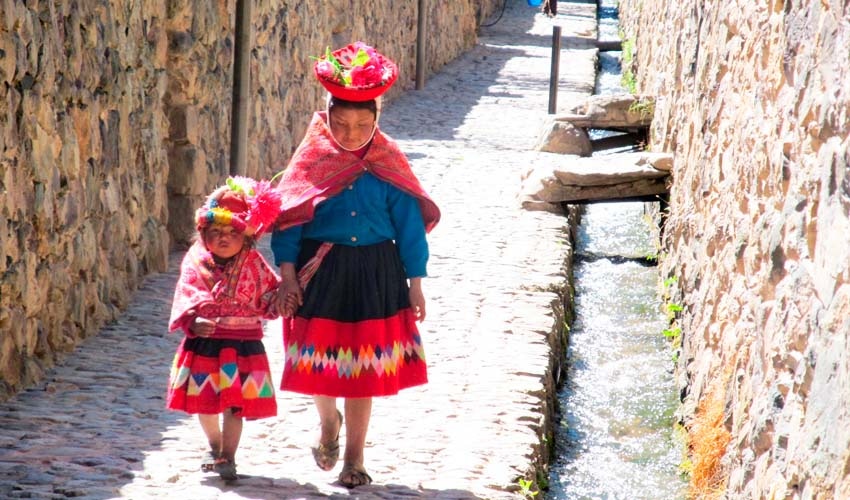
Today, Ollantaytambo is located 2 hours from the main city of Cusco, Peru. It is surrounded by mountains and the Patacancha and Urubamba Rivers, which eventually fall into the Amazon basin.
The town is at an altitude of 2800m and the Ollantaytambo fortress, an Incan showcase of amazing stonework, towers above it and can be seen from anywhere in town. The temple and ceremonial center are located high up 150 steps that separate the top of the fortress from the town. Ollantaytambo is one of the longest continually occupied towns in the Americas, home to hundreds of years of Inca tradition.
Ollantaytambo is a beautiful little town and not only a gateway city to Machu Picchu in Peru, but it is also a destination to be experienced all on its own. It is not yet a tourist city and still has a very local Sacred Valley flavor that makes it a very traditional vacation – complete with its own set of ruins right alongside the town.
First things first: Ollantaytambo is quite the mouthful, so locals call it by its nickname instead: Ollanta.
Now that that’s out of the way, here are the much more important things you will need to know before you visit Ollantaytambo!
The high altitude is a common worry when traveling to Peru. Many tourists fly into Cusco, stay overnight and begin to immediately feel the effects of the high elevation at 11,152 feet (3,399 meters) above sea level.
But instead of staying overnight in Cusco, the best bet to avoid altitude sickness is to make the journey right away to Ollantaytambo in order to gradually acclimate. The town is only 9,160 ft (2,792 m) above sea level and sleeping 3,000 feet lower than in Cusco will be easier on your body initially.
Ollantaytambo sits in a prime location in the Sacred Valley of the Incas. If you use it as your home base you can take many day trips to the key archeological sites that surround you without spending too much precious vacation time on the road – although ‘on the road’ in the Sacred Valley is still definitely a thing to be done because the environment around you is so beautiful.
Heading in either direction from Ollantaytambo will get you to many archeological spectacles.
***This city is also a good base to plan a trip to see Machu Picchu. You can hop on the train in the morning, spend all day hiking and touring the Wonder of the World, and then hop off the last train at night to return to your comfy bed and rest your weary feet. We’ve got more details later in the post
Many of the activities in the Sacred Valley of the Incas require admission. With the Boleto Turistico, a multi day admission ticket, many of those destinations and archeological sites are included.
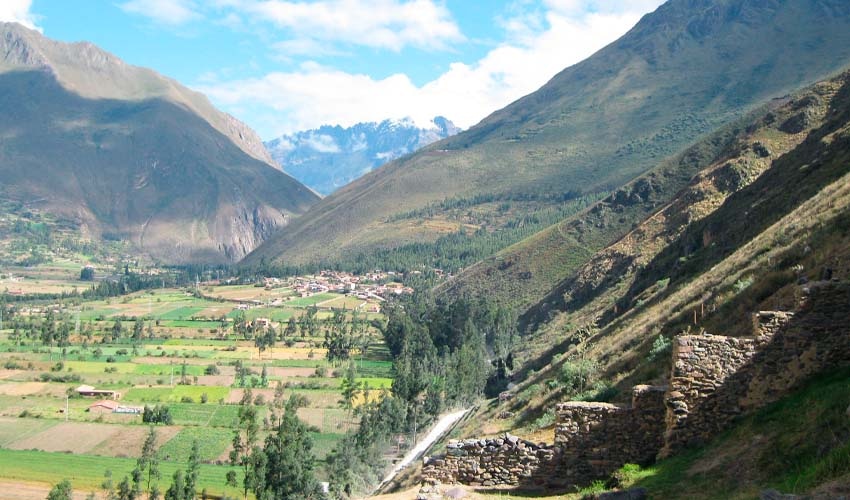
Animal lovers will be delighted to meet and greet dogs everywhere roaming the streets, but also disheartened to see so many strays. We seemed to pass one on every street corner.
Many local volunteer organizations work hard to provide free spay and neuter clinics to help these poor doggies. Some of the strays were taken care of by the entire community and would be taken to the clinics when free services were offered.
Many strays were friendly and only looking for a hand out, but there were also those territorial and aggressive ones that fiercely barked if you got too close to them. One would be wise not to approach any loose dogs while you are walking about in the community because some of them can be real meanies.
Many hotels provide drinking water in your rooms. Restaurants offer bottled water on the menu and will bring it out to your table so that you can watch them break the seal of the new bottle.
But ice lovers, take note: there is never any ice and everything to drink seems to be at room temperature!
We recommend bringing a water filtration bottle or Steri Pen so that you can clean the tap water and have an endless supply of drinkable water.
Ollantaytambo is an Incan archeological wonderland that is located at the northern end of the Sacred Valley in southern Peru, just 45 miles northwest of Cusco.
For any trip to the Sacred Valley, all flights will lead you to the Cusco airport (or, if you are taking the very long overland journey, which I would strongly discourage you from doing, the bus station). From there, there are a few options to get to Ollantaytambo. Which option you choose will depend on your budget, your allotted free time and your ability to acclimate.
When you arrive at the airport, you’ll find plenty of taxi cabs (approximately $25) and inexpensive buses – called combis or collectivos – that hold about 16 people and are about $5 per person. You won’t need to book anything advance, but you will need to be familiar enough with speaking Spanish to negotiate your fare, communicate your destination with your driver, and any other needs you may have along the way (sightseeing stops, bathroom, etc). Taxis are one of the best ways to practice your Spanish!
If your Spanish is not necessarily at Taxi level or you don’t love the idea of “just showing up and figuring it out,” here are a few other options:
If you start in Cusco by arriving at the airport, there are two main road pathways to get to Ollantaytambo, both with great views of the Andes mountains, but also both twisty-turny, so hold on to your lunch – these aren’t for the faint of heart. We traveled once at night and I had to turn on my iPad and focus on it intensely so that I wasn’t so nervous watching all the turns in the road.
Note: As someone who got sick on just about every road in Peru, I highly recommend stocking up on Dramamine before your trip! It’s a lifesaver.
This route goes through Cusco, makes a left turn at the Pisac ruins and continues on through Urubamba on the way to Ollantaytambo. While this way takes about 2 hours longer, it’s a fantastic option if you want to do a few shorter activities along the way.
If you do choose this route, you’ll first drive past Cusco’s 4 main ruins: Sacsayhuaman, Qenko, Puka Pukara, and Tambachay. These ruins are a fantastic introduction to the Cusco city that was once the capital of the Incan Empire, so they are well worth a stop. Helpfully, they’re all included on the Boleto Turistico Ticket and are a great start to learning about the Incan archeology and architecture.
This is the route that we chose, and we set up these stops ahead of time with our Taxidatum driver from Cusco to Ollantaytambo so that we were able to make the stops and then continue on our way with the same driver. It was less of a hassle than continuously calling taxis at every stop!
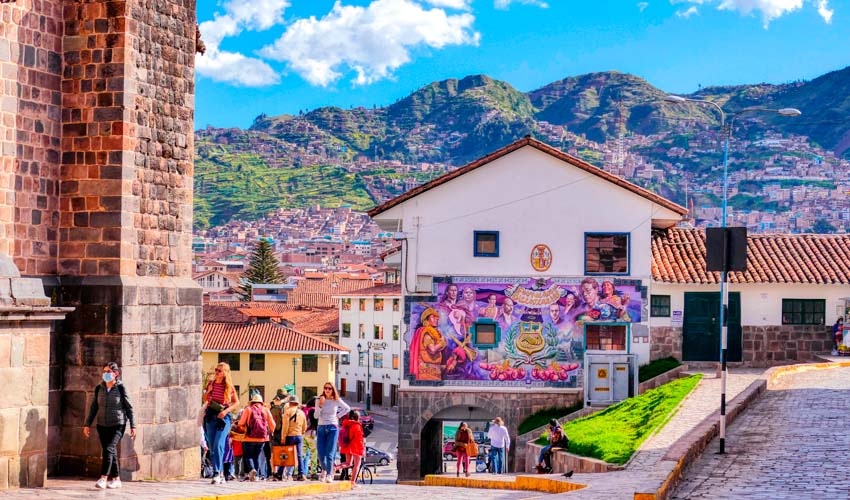
This route is shorter, but still takes about 1 ½ hours of traveling through beautiful scenery. You will pass several archeological sites:
You can coordinate with your driver to stop at these sites, or just book this tour which will take you from Cusco to Ollantaytambo with a stop at each!
If you are well acclimated and are able to do some hiking around, you can fit these into the itinerary as stops on the way to Ollantaytambo. They are interesting and will take at least a good hour if not more each, so adding these stops will definitely increase the length of your travel day.
The entrance to the Ollantaytambo ruins is right in town. Once you enter the site, the beautiful agricultural terraces ascend high into the mountain in front of you and up about 200 steps to the religious sector.
Take your time as you climb, as the altitude and views will again take your breath away – literally! Luckily, there are plenty of benches along the way and you will definitely want to snap a few selfies as you climb your way up.
From your perch high above the town, you will be able to see the carved face of Viracocha, the great Incan Creator, who is facing you on the adjacent mountain.
Along the lower section of the terraces is the princess baths where ceremonial bathing took place. In the 1980s, the Incan water system was re-discovered and you will be able to see the intricate irrigation design that the Incas developed because the water is still flowing today.
Allow yourself about 2 – 3 hours to do this site justice since it is so big! Also, note that the ruins are included in the Boleto Turistico.

Of course, the first thing to do once you finally arrive in Ollantaytambo is to explore the picturesque town! Ollantaytambo is extremely walkable, with narrow streets and few motorized vehicles.
Wander down any of the cobblestone streets and you will have a nice view of the Ollantaytambo ruins on the mountains overlooking the town. Beside you, as you continue on the cobblestone street, there is always a small canal or a stream of running water that is supplied by the mountains and serves as the town’s water supply.
Look for a cute little bridge that connects the square to the market and ruins: the river runs beneath it, making for a stunning photo op.
The town square is a gathering place for the locals. You can plop on a bench and watch the shopping, haggling, mothers carrying their babies on the back in colorful smocks and socializing that goes on daily.
Keep an eye out for locals selling souvenirs in the square. This is a nice way to interact … and get some cheap llama keychains while you are at it.
There are little shops throughout the town, but Ollantaytambo’s main market is just outside the Ollantaytambo ruins exit. After you are done viewing this archeological wonder, you can purchase your fair share of Peruvian textiles and dolls!
There are only about 5 rows of stalls located here, jam-packed with handicrafts and souvenirs of every shape and size.
If you’re looking to experience a larger market, I recommend taking a day trip to Pisac! More details below.
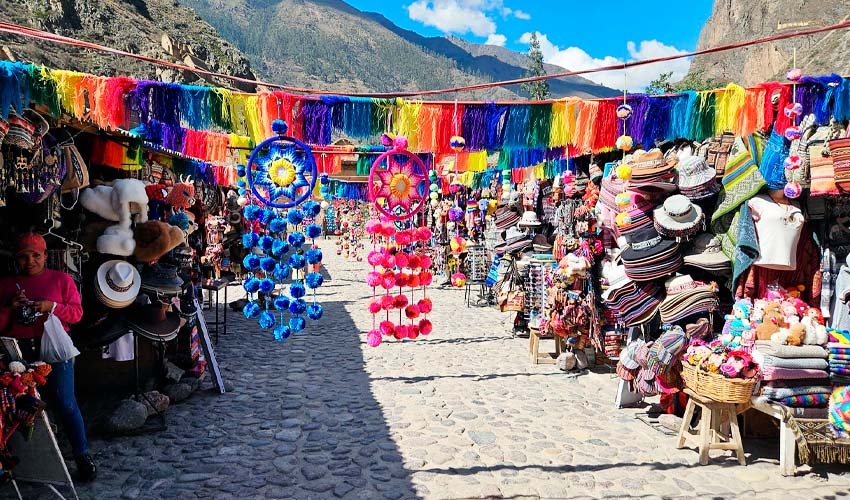
One of the main draws to Ollantaytambo is the culture, which is a blend of Indigenous Quechua traditions and Spanish colonialist influences. But unlike many Latin and American countries, including the USA, in Peru, Indigenous heritage is preserved and still maintained.
As a visitor to Ollantaytambo and the Sacred Valley, you have the incredible opportunity to experience and appreciate this culture, but it’s important to make sure you are doing so ethically and sustainably. Luckily, we have a few suggestions!
First up is a visit to Parwa Restaurante. This excellent restaurant and community-based tourism initiative is the work of a 70-family community in Huchuy Qosqo, which is Quechan for Little Cusco. The restaurant’s ingredients are sourced from village farmers, which helps strengthen the local economy, and all profits from the restaurant are invested back into community development projects. And all you have to do to help is eat!
My second recommendation is an ethical and sustainable tour operator in Ollantaytambo: Awamaki is a non-profit that helps women start and run their own businesses by investing in their skills and leadership and providing a platform to sell their handicrafts online to a global market so they can increase their income and transform their communities.
The Museum of Chocolate, aka the Chocomuseo, is one of our favorite things to do in Ollantaytambo. First of all, there’s chocolate, and second of all, admission is free! Chocomuseo has other locations in Lima and Cusco, but the location here in Ollantaytambo is smaller and a bit more quaint.
That said: don’t expect a giant, educational museum. It’s more like a store selling delicious chocolate.
The museum also hosts chocolate-making classes and cooking classes. The classes are not free and prices range from $12 – $50 depending on how involved you want to get in your chocolate-making knowledge! But if you’re a chocolate lover, this is definitely a must-do in Ollantaytambo.
The Pisac Ruins sit high above the Sacred Valley, the Urubamba River and the town of Pisac, making it difficult to breathe as you hike up and down its trails. Some say these ruins are considered second only to Machu Picchu in splendor. A lot of the architecture is intact and it gives you a great sense of what it was like for the Incas as they went about their everyday living.
To see the Pisac ruins, most people choose to take a taxi to the top of the mountain and hike back down to the town. It is quite a long and difficult walk if you choose to hike UP the mountain.
When we visited I was not feeling my superpowers, just the altitude, so I was panting after a short time exploring! So we just toured the ruins up on top of the mountain and also took our Taxidatum back down.
In addition to a fortress overlooking the valley and the temple, there are many of the Incan agricultural terraces carved into the mountains. These same terraces are found throughout the Sacred Valley and were used to grow different crops at each of the terrace levels.
On Sundays, Tuesdays, and Thursdays you will find the enormous Pisac Market (which is still operated on the other days, but not quite as enormous). This is the largest display of souvenirs, textiles, vegetables, varieties of potatoes, stuffed llamas and every other possible knick-knack that I saw throughout Peru. I love to buy souvenirs when I vacation and this was the perfect place!
I knew the Pisac market was coming up on our trip itinerary, so I saved all my soles for that shopping trip and was not disappointed. The only disheartening part of my shopping experience was that I didn’t have unlimited storage space in my luggage and couldn’t fit everything my heart desired into the remaining space I had.
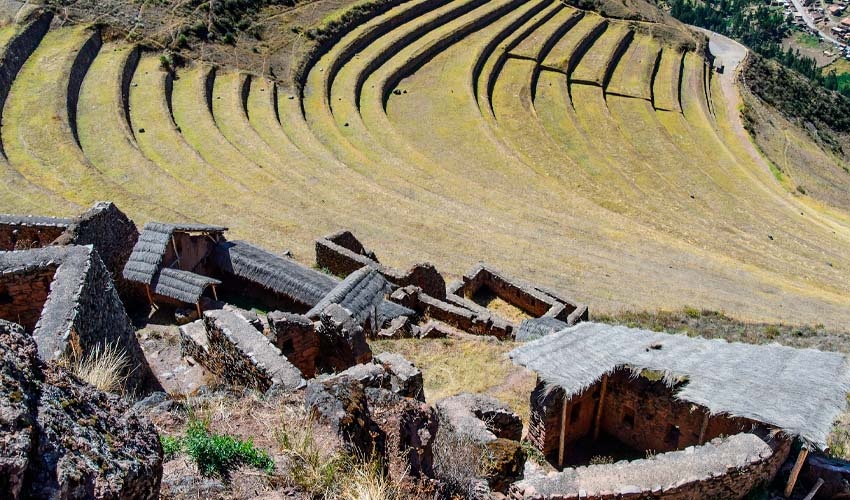
Located just under an hour from Ollantaytambo, the archeological complex of Moray is an incredible vision to see and is included in the Boleto Turistico. It is thought that this was the agricultural laboratory of the Incas. Here, the iconic Incan terraces at Moray are built in perfect circles that resemble amphitheater seating!
The site is founded in highly advanced engineering and agricultural science: by creating a microclimate at each level, the terraces enabled different food crops to be grown and tested. Peru is known for its variety of potatoes and it’s likely that many of the 3,000+ different variations were invented at this site. I don’t think I tried quite that many different potato dishes during my time in Peru!
To get to Moray, you can either take a colectivo (the cheapeast option, as always) or a taxi. Or, you can visit both – and take in stunning scenery – via bike as part of a Sacred Valley bike tour!
Just a short taxi ride from Moray, the Salineras de Maras, aka the Maras Salt Mines, are the ancient salt pans in the Sacred Valley. They are fed by a natural spring and after the water evaporates (or is directed elsewhere), the salt is left behind.
Since the 1400s, in the times of the Incas, each family in the local community has the right to one of the ponds and passes on this ownership to the next generation in their family. The family owns their single pond and harvests the salt by scraping the crystals from the side of their pond after the natural spring water evaporates.
The harvested salt is sold in the markets and the local communities by each family and provides them with a small income. There is no mass production system going on here! The whole process is still the same as it was from thousands of years ago.
You can view the Peruvians collecting the salt in large bags to carry on their backs in order to package up in small bags. These bags are also for sale at the entrance to the Maras Salt Ponds and can be purchased for as little as $1 USD.
There used to be a path among the ponds that tourists could walk along, but this has recently closed and the viewing is restricted only to the observation platform now. The paths closed right after we got back from our trip, citing that too many tourists were straying off of the path and contaminated the salt. I feel lucky that we were one of the last people that were able to walk along these pathways, but saddened by the fact that humanity was actually destroying an important community resource.
Pinkuylluna was once a storehouse that the Incas built high in the mountains, thought to be safe and protected from enemies. The lower temperature and higher winds prevented the decay of their food supply.
Today, the granary is free to explore, although few tourists know about it – or else most of them are just too chicken to attempt the climb?
To reach the granary, you’ll need to take a narrow path that sometimes resembles the very edge of the mountain. The Pinkuylluna hike is not for the faint of heart, and it is a fairly long hike up so make sure that you are well acclimated before attempting this and bring plenty of water!
You didn’t think we’d get through a whole post about things to do in Ollantaytambo and not include the big one, did you? After all, there’s an excellent chance that Machu Picchu is the primary reason for your visit to Ollantaytambo!
Machu Picchu is found high in the Andes Mountains in Peru and is the most famous example of 15th century Incan architecture. It was built for the Inca emperor Pachacuti and later abandoned due to the Spanish conquest.
The ruins were rediscovered in 1911 by an American historian and quickly sky-rocketed in popularity to become one of the new seven wonders of the world and a UNESCO World Heritage Site.
By today, most of the outer buildings have been reconstructed and views of the city enable one to imagine how the everyday Incan life went about.
Visiting Machu Picchu is not as easy as it once was. Recently, the Peruvian government has been trying to regulate the number of daily visitors in order to preserve the archeological site and prevent damage due to excessive tourism. Visitors must commit to a day and an entrance time in advance, and a limited number of tickets for each are available
To avoid standing in long lines or being denied entry, you’ll want to purchase your tickets to Machu Picchu well ahead of time, especially if you’d like to do any hikes within Machu Picchu itself. Pick up a ticket here, or purchase online directly from the Ministerio de Cultura which is a bit more complicated but may be cheaper.
A guide (or a guidebook!) is not only helpful in order to understand this huge ancient site, but a new rule states that all tourists must have a guide to visit Machu Picchu. However, when we hired our guide at the gate entrance, he was held up talking to other people and didn’t come in with us, so we actually went inside the site on our own without question. I am not sure how or when they will be able to start enforcing this new rule, but you’re better off following it than getting kicked out!
Hiring a guide at the entrance is the cheapest option: look for professionals in beige vests and lanyards, and be sure to chat with them to make sure your language abilities (or lack thereof) will be accommodated. That said, it’s much easier to just book a tour in advance, like this one.
After touring the grounds with your guide, there are several self-guided hikes you can do to make the most out of your day in Machu Picchu.

During your time in Ollantaytambo, you will become a part of this little town for a short time and live the life of the locals, walking along the cobblestone streets and shopping in the little shops in the square. So it should come as no surprise that unlike Cusco or Lima, there are no Marriots or high rise hotels to stay in! That said, there are plenty of charming boutique hotels available for incredibly reasonable prices.
One important thing to note is that there is a long road from the train station up to town, all UPHILL, so if you are planning to walk this road, you should choose something on that side of the square. This long walk can be extra tiring when you arrive on the last train at 11 pm, especially after a long day of hiking at Machu Picchu. You can, of course, always take a taxi.